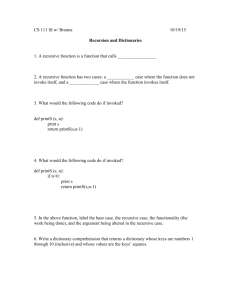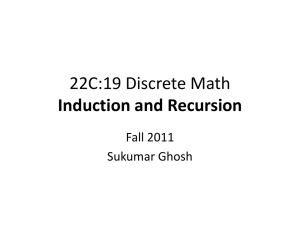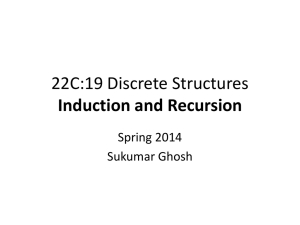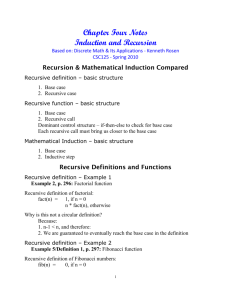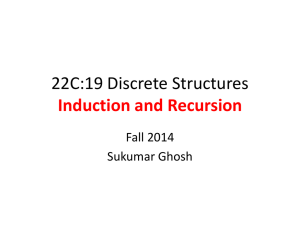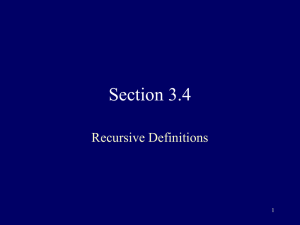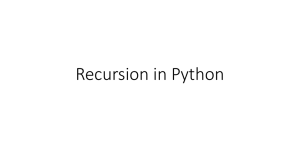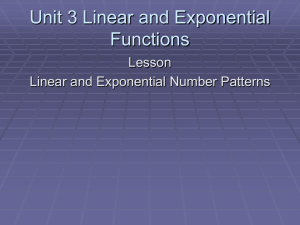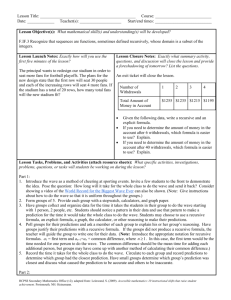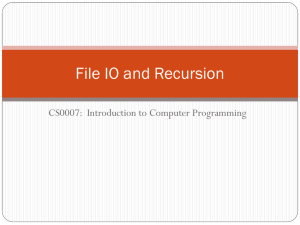download_pptx
advertisement
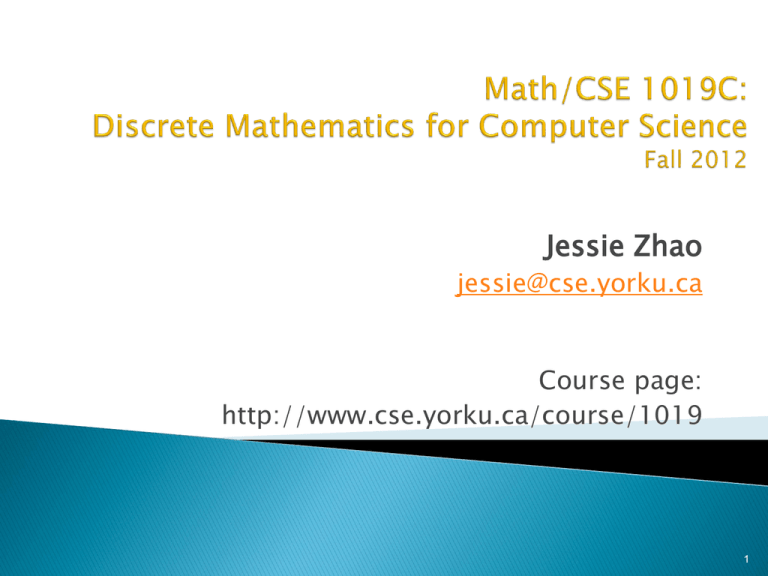
Jessie Zhao
jessie@cse.yorku.ca
Course page:
http://www.cse.yorku.ca/course/1019
1
Test 3
◦
◦
◦
◦
Nov 26th, 7pm-8:20pm
Ch 2.6, 3.1-3.3, 5.1, 5.2, 5.5
6 questions
Locations
SLH F (Last name A-L)
SLH A (Last name from M-Z)
2
Recursive definition: define an object by itself
Geometric progression an =arⁿ for n=0,1,2,...
◦ A recursive definition: a0 = a, an=r an-1 for n=1,2,...
Arithmetic progression an =a+dn for
n=0,1,2..
A recursive definition: a0 = a, an= an-1+d for n=1,2,...
3
1. Basis step
◦ For functions: specify the value of the function at
zero
◦ For sets: specify members of the initial set
2.Inductive or recursive step
◦ For functions: Show how to compute its value at an
integer from its values at smaller integers.
◦ For sets: Show how to build new things from old
things with some construction rules
4
Suppose f(0)=3, and f(n+1)=2f(n)+2, ∀n≥0.
Find f(1), f(2) and f(3).
Give a recursive definition for f(n)=n!
Give a recursive definition for f(n)=2
5
Recursive definition:
◦ 1. Basis:
f(0)=0, f(1)=1 (two initial conditions)
◦ 2.Induction:
f(n)=f(n-1)+f(n-2) for n=2,3,4... (recurrence equation)
Practice: find the Fibonacci numbers
f2,f3,f4,f5, and f6
6
Proof of assertions about recursively defined
objects usually involves a proof by induction.
◦ Prove the assertion is true for the basis step
◦ Prove if the assertion is true for the previous
objects it must be true for the new objects you can
build from the previous objects
◦ Conclude the assertion must be true for all objects
7
Example: For Fibonacci numbers prove that
fn>αn-2 when n≥3, where α=(1+√5)/2
Proof by strong induction: P(n) is fn>αn-2
◦ Basis step:
n=3, α<2= f3 , so P(3) is true.
n=4, α2 =((1+√5)/2) 2 =(3+√5)/2<3= f4 , so P(4) is true.
◦ Inductive Step:
Assume P(j) is true, i.e. fj>αj-2 for 3≤j≤k, where k≥4
Prove P(k+1) is true, i.e. fk+1>αk-1
fk+1 =fk +fk-1 ≤αk-2 +αk-3 =(α+1) αk-3 = α2 αk-3 = αk-1
α+1= α2
8
Give a recursive definition for the following
sets:
◦ Z+
◦ The set of odd positive numbers
◦ The set of positive numbers not divisible by 3
9
A string over an alphabet Σ is a finite
sequence of symbols from Σ
The set of all strings (including the empty
string λ) is called Σ*
Recursive definition of Σ*:
◦ 1. Basis step: λ∈Σ*
◦ 2.Recursive step: If w∈Σ* and x∈Σ, the wx∈Σ*
Example: If Σ={0,1}, then
Σ*={λ,0,1,00,01,10,11,...} is the set of bit
strings
10
Example: Give a recursive definition of the set
S of bit strings with no more than a single 1.
◦ 1. Basis step: λ, 0, and 1 are in S
◦ 2.Recursive step: if w is in S, then so are 0w and w0.
11
Recursive definition of the length of a string
l(w)
◦ 1. Basis step: l(λ)=0
◦ 2.Inductive step: l(wx)=l(w)+1 if w∈Σ* and x∈Σ
12
◦ Input: n: nonnegative integer
◦ Output: The nth Fibonacci number f(n)
Fib_recursive(n)
◦ If n=0 then return 0
◦ Else if n=1 then return 1
◦ Else return Fib_recursive(n-1)+Fib_recursive(n-2)
Correctness proof usually involves strong
induction.
13
Iteration: Start with the bases, and apply the
recursive definition.
Fib_iterative(n)
◦ If n=0 then return 0
◦ Else x←0,y ←1
For i ←1 to n-1
z ← x+y
x ←y
y ←z
return y
14
Time complexity
◦ Fib_recursive(n): exponential
◦ Fib_iterative(n): linear
Drawback of recursion
◦ Repeated computation of the same terms
Advantage of recursion
◦ Easy to implement
15
Merge_sort(A,lo,hi)
◦ Input: A[1..n]: array of distinct numbers, 1≤lo<hi≤n
◦ Output: A[1..n]: A[lo..hi] is sorted
If lo=hi
return;
else
Mid=⌊(hi+lo)/2⌋
Merge_sort(A,lo,mid)
Merge_sort(A,mid+1,hi)
A[lo,hi]←merge(A[lo,mid],A[mid+1,hi])
16
Correctness proof
Inductively assume the two recursive calls
correct
Prove the correctness of the merge step
By strong induction the algorithm is correct
17
Why count?
◦ arrange objects
Counting Principles
◦ Let A and B be disjoint sets
◦ Sum Rule
|AUB| = |A| + |B|
◦ Product Rule
|AxB| = |A|⋅|B|
18
Example: Suppose there are 30 men and 20
women in a class.
◦ How many ways are there to pick one representative
from the class?
50
◦ How many ways are there to pick two
representatives, so that one is man and one is
woman?
600
19
Example: Suppose you are either going to an
Italian restaurant that serves 15 entrees or to
a French restaurant that serves 10 entrees
◦ How many choices of entree do you have?
25
Example: Suppose you go to the French
restaurant and find out that the prix fixe
menu is three courses, with a choice of 4
appetizers, 10 entrees and 5 desserts
◦ How many different meals can you have?
200
20
How many different bit strings of length 8 are
there?
28
How many different bit strings of length 8
both begin and end with a 1?
26
How many bit strings are there of length 8 or
less?
28 +27 +…+20 (counting empty string)
How many bit strings with length not
exceeding n, where n is a positive integer,
consist no 0.
n+1 (counting empty string)
21
How many functions are there from a set with
m elements to a set with n elements?
nm
How many one-to-one functions are there
from a set with m elements to one with n
elements?
n(n-1)...(n-m+1) when m≤n
0 when m>n
22
IF A and B are not disjoint sets
|AUB| = |A| + |B| - |A∩B|
Don’t count objects in the intersection of two
sets more than once.
What is |AUBUC|?
23
How many positive integers less than 1000
◦ are divisible by 7?
⌊ 999/7 ⌋ = 142
◦ are divisible by both 7 and 11?
⌊999/77 ⌋ = 12
◦ are divisible by 7 but not by 11?
142-12 = 130
◦ are divisible by either 7 or 11?
142+ ⌊ 999/11 ⌋ -12 = 220
◦ are divisible by exactly one of 7 and 11?
142+ ⌊ 999/11 ⌋ -12-12 =208
◦ are divisible by neither 7 nor 11?
999-220 = 779
24
